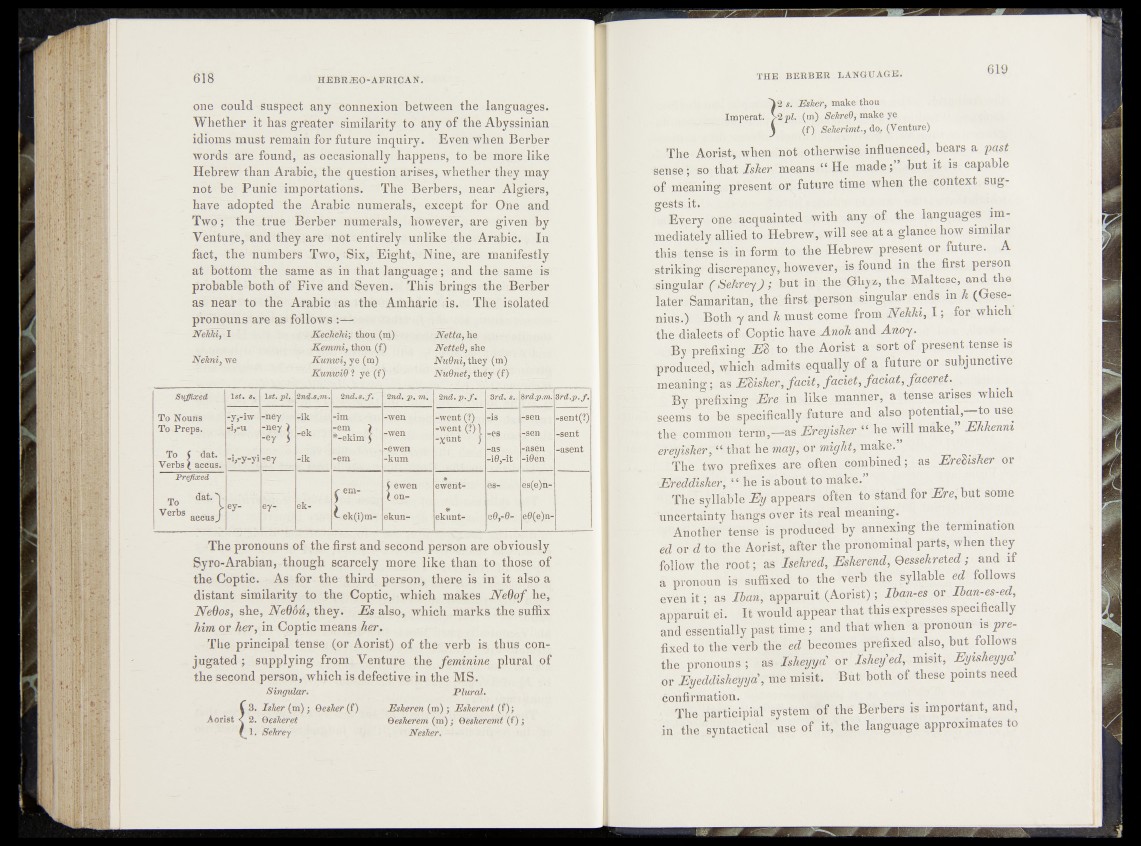
one could suspect any connexion between the languages.
Whether it has greater similarity to any of the Abyssinian
idioms must remain for future inquiry. Even when Berber
words are found, as occasionally happens, todbe more like
Hebrew than Arabic, the question arises,' whether they may
not be Punic importations. The Berbers, near Algiers,
have adopted the Arabic numerals, except for One and
Two; the true Berber numerals, however,: are given by
Venture, and they .are mot entirely unlike the Arabic. In
fact, the numbers Two, .'Six, Eight,''Nine, are manifestly
at bottom i;he same as in that language; and the same is'
probable both of Five and?Seven. This brings?the Berber
as near to the Arabic as * the Amharie ; is. The^isolated
pronouns are as follows
Nehki^I '
N ekn i,we
Kechchv, thou (m)
Kemmi, thou ( |)
Kunwi, ye (m)
KunwiO ? y e 'irj' K>
Metta, he
NftteO,. she
Nuffni^viey (m)
NuQnetj they (£)■’
Suffixed j. is*. 1et. j&K 2 nd.s.m. 2nd. " 2nd. p .m . 2nd.p.~Jl.‘. Srd. s.i. fyd.p.m. Srd.p.f.
To Nounfs -yy-iw -ney -ik -im -wen -went r43 j ; -sen -1 -sent(?)
To Preps. -i,-u -n e y ji
S -ek -em >
*-ekiin J cwen ^went c b - f
? ' f -sent
To I dat.
Verbs \ ace us.
-ewen -as rpiSen v -asent
-b-y-yi -ey -ik -em -kum -i0,-it -i@en-
Prefixed |
es(e)ne0(
a)n-
To
Verbs aecus J
ey- ekr
em- -
^ ek(i)mf
ewen
( onekunewènt
*
ekimt-
Jd. 11
CD 1
The pronouns of the first and second person are obviously
Syro-Arabian, though scarcely more like than to those. q$
the Coptic. As for the third person, there is in .it also a
distant similarity to the Coptic, -which makes JYeOof he,
JVeOos, she, JVeOdd, they. Es also, which marks the suffix
him or her, in Coptic means her.
The principal tense (or Aorist) of the verb is, thus, conjugated
; supplying from. Venture the feminine plural of
the second person, which is defective in the MS.
Singular. P lu ra l.
v 3 . Tafter(m); Qether(f) JBskeren (m) j Esher ent (f);
Aorist < 2. Qetheret Qesherem (m); Q&skeremt (f) j
f 1 . Sekrey ■> Nether. —-
T 2 si, Esher, make tkoa
- Im p e ra t.. ■ (m) . Sehred, make ye
3 j f X SeheAmt., do^ (Venture)
The Aorist*.when not otherwise influenced, bears a past
sense; so that meansAIHe..madebut it is capable
of meaning present, or.futuretime when the context suggests:,
it. , v >\ * •< 11
Every^:ö#euacquainted,-with .any .of the languages immediately
allied;,tQ Hebrew, will see(at a glance, how similar
•this tense is inform to the Hebrew present;or future. A
■striking discrepancy1,' however, is found in the first person
singular fSekreyJ ; but in; the Ghyz, the, Maltese, and the
later Samaritan, the fersb person -.singular .ends, in h (Ges.e-
niifs^!i Both y and k mujsj.come from Nekki, I ; for which
"the;.dialects of Coptic haveAnoh and Anoy.
By prefixing ES- to the .Aorist a-sort of present .tense is
-produced/, which: admits equalfy of a future pr . subjunctive
meaning,.;-, as ESisher.,. facit, faciei, facial, facer et.
By prefixing -Ere in like manner, a-tense arises which
SJeMs-to b,e specifically future and also potential,—to use
thu; common^term,—as Ereyisher “ he will make,” Ekkenni
'■eHk&Jiër?1* that.be may, otmigM/vnike”
The two prefixes are often combined; as EreSisker or
Ereddisker, “ be is about to m a k e l t - .
T h f ip a b l e % appears often to-stand for Ere, but some
uncertainty hangs over its real meaning.
Another tense'is produced by annexing the termination
ed or d to the Aorist, after the pronominal parts, when they
follow the root; as Isekred, Eskerend, Qessekreted; and if
a pronoun is suffixed fo the verb the syllable ed follows
even i t ; as Than, apparuit,.(Aorist) Iban-es or Iban-es-ed,
apparuit ei. It would appear: that this expresses specifically
and essentially past time ; and that when a pronoun^ prefixed
to the verb the ed becomes prefixed also, but follows
the pronouns ; ^ Isheyya or Mefed, Eyisheyyd
or Eyeddisheyya', me misfit. But both of these points need
confirmation. ‘ .
The participial system of the Berbers is important, and,
in the syntactical use of it, the language approximates to